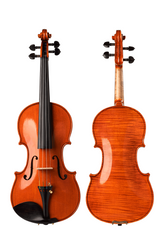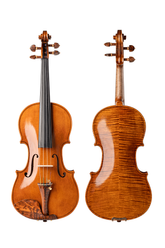The Impact of Violin Bridge on Violin Tone Quality
The violin bridge, also known as the "bridge," is the largest sound-producing component inside a violin, apart from the body itself. It is often referred to as the "throat" of the violin and serves as the most critical medium during the transmission of vibrations. During the process of transmitting vibrations, the bridge is highly sensitive, and any minor adjustments can have a profound impact on its sound production.
While performing, violinists need to make appropriate selections and adjustments to the bridge to achieve a more perfect violin tone. In the process of transmitting vibrations, the bridge plays an indispensable role. It is highly sensitive, and even the slightest alterations can significantly affect its sound production.
Material
The material of the violin bridge has a significant impact on the violin's tone quality. Factors such as the density, strength, hardness, and elasticity of the selected wood can influence the vibration frequency and transmission speed of the sound. Many accomplished musicians tend to prefer bridge materials that are somewhat on the harder side, like the Deluxe bridge. This preference is due to the fact that a softer bridge can absorb more vibrations, but when these vibrations are transmitted to the violin body, they may not be sufficient, resulting in an inferior tone. Using a bridge with a somewhat harder material can better transmit vibrations and enhance the volume.
On the other hand, for regular violins, a bridge made from softer material like Aubert is commonly used. This choice is not solely determined by the volume produced, as the quality of the tone is not solely dependent on it. When the bridge material is relatively hard, it has greater hardness and less deformation. However, this can lead to a reduction in the duration of the panel's vibration, resulting in a less smooth and gentle tone. Additionally, using a bridge with a greater hardness can introduce more noise when playing the violin. Therefore, during the performance, if the violin produces excessive noise, a thicker and softer bridge should be selected. Conversely, if the tone quality is pure but the volume is low, a thinner and harder bridge should be chosen.
Polishing
Violin bridges are mostly sold in a semi-finished state and require musicians to polish them according to the specific needs of their violins. The polishing process can also have an impact on the violin's tone quality. After polishing, the feet of the bridge should fit snugly against the violin's surface, and there should be a slight central arch.
Furthermore, it's crucial that the feet of the bridge are neither too thin nor too thick. If the feet are too thin, they can concentrate the pressure generated by the violin strings onto a small area, without distributing it evenly. When the pressure reaches a certain level, it can significantly increase the stress on the connection between the violin's body and the bridge, potentially causing damage to the violin's surface. Conversely, if the feet of the bridge are too thick, it can affect the violin's sound projection flexibility.
In general, if the violin's surface is relatively thick, the bridge should be thinner, and if the surface is thinner, the bridge should be slightly thicker.
Height
The distance between the violin strings and the fingerboard surface typically depends on the height of the bridge. If the bridge height is not suitable, it can affect the musician's playing experience and also influence the violin's vibration, thus impacting tone quality and volume. In general, if the bridge height is lower, the sound produced by the violin tends to be relatively soft but lacks projection and volume. Conversely, if the bridge height is higher, the violin's sound becomes sharper, with greater volume and projection, but it may lack the smoothness of tone.
Additionally, the bridge height is also influenced by the curvature of the violin's surface. When the surface curvature is more pronounced, a bridge with a relatively lower height is preferred, whereas a surface with a smaller curvature benefits from a bridge with a relatively higher height.
Position
From a theoretical perspective, the central part of the violin's soundboard is the optimal location for installing the violin bridge. In the actual installation process, to find the best placement for the bridge, one must first identify the positions that are most likely to generate resonance in the violin body and soundboard vibrations. Additionally, it's essential to ensure that the bridge complements the overall violin structure. Based on the principles of violin sound production and manufacturing experience, the best installation position for the violin bridge is typically between the two F-shaped soundholes on the soundboard. Furthermore, the bridge should be installed with these holes as reference points.
Therefore, the range for bridge installation on the violin soundboard is relatively small, and the extent of adjustment required is also limited. It's important to note that the distance between the two bridge feet to the inner edges of the holes must be equal to ensure that the violin's tone remains unaffected.
If you don't know how to install the violin bridge, you can watch the video below to learn more.





